
PREV ARTICLE
NEXT ARTICLE
FULL ISSUE
PREV FULL ISSUE
JOHN W. ADAMS COMITIA AMERICANA MEDALSThe 110-lot Stack's Bowers sale of the John W. Adams Collection of Comitia Americana and Related Medals is a highlight of the firm's upcoming November Baltimore sales. Here are some selected pieces, but see the complete catalog for much more. This is a rare opportunity to acquire some of the rarest and most important medals in American history. -Editor Lot 2001: Original Silver Washington Before Boston Medal
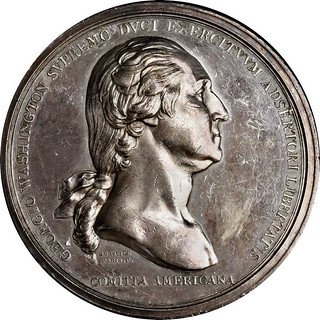 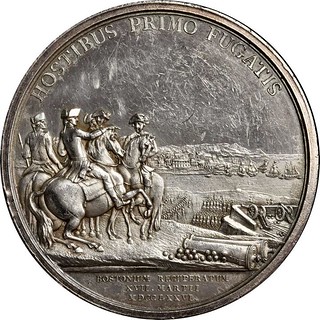 1776 Washington Before Boston medal. Betts-542, Musante GW-09-P1, Baker-47, Mooney M5. Silver. Original striking. Paris Mint. 69.0 mm, 2301.1 grains. 4.3 - 4.6 mm thick. About Uncirculated. Plain square edge. A magnificent specimen of this most august of all American medals, the first medal ever authorized by the Continental Congress and the #2 ranked medal among the 100 Greatest American Medals and Tokens, trailing only the Libertas Americana medal. While any specimen of the Washington Before Boston is impressive, showcasing the superb relief of Duvivier's version of the famed bust by Jean-Antoine Houdon, numismatists cherish original strikings above all others. Among originals, the dramatic importance of Washington's unobtainable gold specimen is followed closely by the nearly unobtainable silver strikings like this one. Obverse: A profile of Washington, after Houdon's masterful bust, with hair tied with a ribbon and the bust neatly truncated. Duvivier's signature DuVIVIER / PARIS F. appears on two lines beneath the bust truncation, while COMITIA AMERICANA appears on a straight line in the unbordered exergue. The peripheral inscription GEORGIO WASHINGTON SVPREMO DVCI EXERCITVVM ADSERTORI LIBERTATIS translates to "George Washington, supreme commander of the armies, defender of liberty." Reverse: Washington, on horseback at left, stands with four mounted officers overlooking Boston and its harbor from Dorchester Heights. Ships at full sail depart at right on the horizon, while troops, cannons on their carriages, stacked cannonballs, and two unmounted cannon are at Washington's right. Washington gestures to the scene below. The legend HOSTIBUS PRIMO FUGATIS means "the first flight of the enemy," while the exergual legend BOSTONIUM RECUPERATUM XVII MARTII MDCCLXXVI means "Boston recovered, March 17, 1776." One of only five in private hands. See the catalog description for much more information on one of the most important medals in U.S. history. I'm glad to see reference to the study of Washington Before Boston medals by my numismatic mentor Glenn A. Mooney of Pittsburgh. -Editor To read the complete lot description, see:
Lot 2053: Silver Daniel Morgan at Cowpens Medal
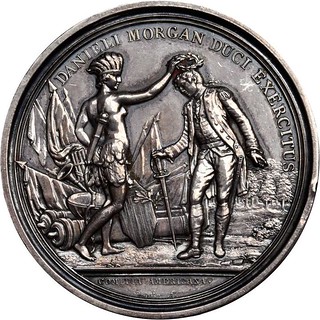 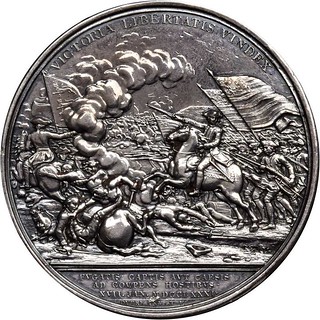 1781 Daniel Morgan at Cowpens medal. Betts-593. Silver. Original. Paris Mint. 56.1 mm, 1211.8 grains. 4.6 - 4.8 mm thick. Choice Extremely Fine. Any original Morgan at Cowpens medal is of the highest rarity, even those struck in bronze. For whatever reason, these dies were never employed to produce restrikes at Paris like the dies for George Washington, Jones, Howard, and William Washington, nor were they carried to the Philadelphia Mint like the dies for Horatio Gates' medal. Instead, like Dupre's dies for the Nathanael Greene medal, a small run was made at Paris roughly contemporary to the production of the original gold medal and the dies were never used again. The Adams-Bentley census found three silver originals: the MHS piece, the one in Vienna's Kunsthistoriches Museum, and this one, the sole survivor in private hands. Among the seven original bronzes they listed, only three were privately held. The second of the bronzes in this collection appears to be unlisted in the Adams census, leaving a total collectible population from Dupre's original dies of just six pieces, of which this is the only silver strike that has survived outside of an institution. When this medal brought $80,500 when it last sold in May 2001, it shattered a decades old record for the highest price realized by an American historical medal - $51,000 - formerly held by Anthony Wayne's own gold Comitia Americana medal, sold by Sotheby Parke-Bernet in 1978. As a contrast, in May 1999, just two years before this medal created a new price structure for rare American medals, Harry Bass's gem silver Libertas Americana medal realized $19,550 (now the price of a mediocre Mint State bronze specimen of the same medal) and his exceptional silver De Fleury medal realized $27,600. The record this medal set did not stand long. Before 2001 had ended, a Thomas Jefferson Indian Peace medal had crossed the six-figure mark, netting $115,000 in November 2001. Five years later, in November 2006, Zachary Taylor's Congressional gold medal for the Battle of Buena Vista brought $460,000. Arguably, the Taylor medal record as most valuable American medal ever sold still holds, as other medals that have realized higher sums (like James Watson's Nobel prize and Jesse Owens' Olympic gold medal) are not of American manufacture despite their American relevance. Of course, at this point, dozens of medals have brought prices that surpass the $80,500 this medal brought in 2001. Not counting the 1936 Nobel Peace Prize we sold in 2014 for $1,116,250, this firm has sold no fewer than 46 medals for more than $80,000 (not counting all of the 1776 Continental "dollars" that could probably now be added to the list). Every one of those sales has happened since this medal first broke that barrier. Obverse: The traditional reverse was considered the ob.verse by the Academy of Inscriptions and Belles-Lettres and by Jefferson himself. Alas, we hew to numismatic tradition. With flags and cannons - the traditional trophies of war - at left, the goddess America in her traditional garb and holding her traditional shield crowns Morgan, at right, with a laurel wreath. Morgan bows slightly, his sword grounded, with the rural scene of battle seen behind him. Beneath the exergue are the words COMITIA AMERICANA. Around the periphery: DANIELI MORGAN DUCI EXERCITUS or "Daniel Morgan, head of the army." Reverse: Perhaps the most impressive and evocative battle scene in the realm of American medallic art, at least until the Mexican-American War masterworks of Charles Cushing Wright. Morgan, in the saddle and pointing forward with his sword, leads his soldiers from right to left. The Cowpens flag flies behind him at the front of his troops, who carry their muskets with bayonets fixed. A native ally stabs a fallen British cavalryman in the lower left, while other British troops, one mounted, scramble. A British flag and smoke rise from the left. The legend above VICTORIA LIBERTATIS VINDEX means "Victory is Liberty's defender." In the exergue, FVGATIS CAPTIS AVT CAESIS AD COWPENS HOSTIBVS XVII. JAN. MDCCLXXXI means "The enemy chased, captured, or killed at the Battle of Cowpens, January 17, 1781." In the lower exergue, Dupre signs DUPRE INV ET F or "Dupre conceived and made it." Of course, the medal's history is the most important story, but its role as a price-barrier-breaker is interesting. I've been predicting and watching breakout price records for rare medals for some time. -Editor To read the complete lot description, see:
Lot 2090: Original Libertas Americana Medal
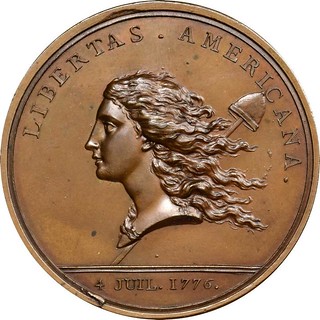 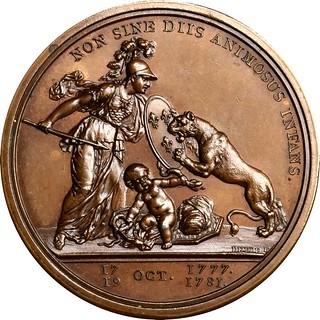 1781 Libertas Americana medal. Betts-615. Copper. Original. Paris Mint. 47.8 mm, 725.8 grains. 3.5 - 3.6 mm thick. Choice Mint State. It is well known that Benjamin Franklin preferred Dupre's majestic design in copper. "The Impression in Copper is thought to appear best," Franklin wrote to Robert Livingston on April 15, 1783, though one wonders if he might have written something different if the piece he enclosed for Livingston was a silver one. Copper specimens like this one were sent to the members of Congress and other functionaries close to the government; it seems likely that more copper pieces were distributed in the United States than in France. Cognizant of the historic moment they occupied, and appreciative of Franklin's largesse, it seems that most recipients of a Libertas Americana medal cherished it. The bulk of the mintage seems to have survived. Of course, to an 18th century non-numismatist, cherishing something meant handling it, displaying it, perhaps cleaning it now and again, thus few survive in Gem condition. The total population - perhaps 200 or so - is heavily weighted toward those with some handling. Not one in ten is as nice as this one. The Libertas Americana Medal
While not properly a part of the Comitia Americana series - it was a medal authorized by Benjamin Franklin as an individual, not the Continental Congress - the Libertas Americana medal has been adopted into this group ever since Thomas Jefferson saw fit to place one in George Washington's set of Comitia Americana medals in the summer of 1789. By that time, the medal was several years old, as it had been completed and distributed by Franklin in the spring of 1783. Franklin sent his medal far and wide, in France, in the United States, and beyond. His postal accounts show that in April 1783 he twice hired a carriage to special deliver his medal to its recipient. Jefferson had one on display at Monticello, inventoried as "a medal by Dr. Franklin." The Dutch artist Johann-Georg Holtzhey had a friend write to John Adams to ask how he and his friends could obtain one. As the medals found their homes in April and May 1783, Franklin's mailbox filled up with thank you notes from across the continent. On April 15 of that year, Franklin sent a bundle of them to Philadelphia to hand out to the members of Congress, including a silver one for Congress' president, future Mint Director Elias Boudinot. Obverse: "The Head representing American Liberty has its tresses floating in the air, to shew that she is in activity. The Cap carried on a Spear is her Ensign. The Date underneath is that of the Declaration of Independence." Reverse: "The United States of America are represented by an Infant Hercules, cradled in a Buckler to shew that they are nursed in War. A Leopard, representing England, comes with two serpents to destroy the Infant. France represented by a Minerva, comes armed to his succour, and under her protection he strangles the two serpents, while she guards him from the Leopard, by her shield marked with Fleurs-de-Lis. The Legend is a line of Horace, importing that the Infant was not without divine assistance. The Dates below are those of the two Capitulations of Saratoga & York-Town, whereby two entire English Armies that had enter'd and ravaged the United States with fire & sword, were extinguished." In Franklin's symbolism, this depiction recalls Hera, the stepmother of Hercules, releasing two snakes to kill Hercules in his cradle; those two snakes were the armies of Burgoyne (defeated at Saratoga) and Cornwallis (defeated at Yorktown). To read the complete lot description, see:
Lot 2109: United States Diplomatic Medal
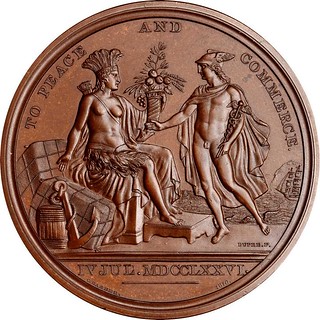 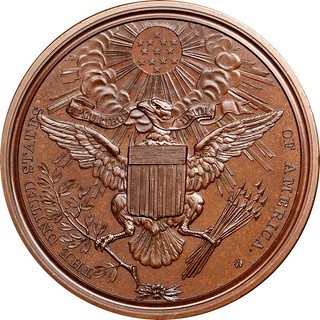 "1776" (after 1876) United States Diplomatic medal. Loubat-19, Julian CM-15. Copper. U.S. Mint copy dies by Barber (1876). Philadelphia Mint. 67.9 mm. 2432.4 grains. 6.0 - 6.3 mm. Choice Mint State. This is a very scarce medal. A single silver specimen is recorded on the mintage figures for the 1876/77 fiscal year, likely the one sent in April 1876 to Professor Jules Marcou, who supplied his original Diplomatic Medal cliches to the U.S. Mint to serve as models for William Barber's copy dies. According to Mint records, just 65 pieces were struck in copper from these dies between 1876 and 1904. Originals are beyond the realm of possibility for most, making this version of the Diplomatic Medal a very desirable item. The Chapmans bitterly called this production a "US Mint counterfeit" after they failed to sell their original to the Mint Collection. The Diplomatic Medal
Obverse: The first version of the Great Seal of the United States ever executed in medallic form, correctly showing the olive branch of peace at dexter (eagle's right) and the arrows of war at sinister (eagle's left, viewer's right). The eagle holds a banner inscribed with the national motto E PLURIBUS UNUM in his beak and an escutcheon or shield is displayed on his breast. A glory of 13 stars is atop the obverse, and the legend THE UNITED STATES OF AMERICA surrounds the arms at the periphery. Reverse: An allegory of America, in her common guise as a Native American princess, holds a cornucopia or horn of plenty and gestures to bundles and a hogshead beside an anchor. She is approached by Mercury as Commerce, holding his caduceus. A ship representing Atlantic commerce and interactions with Europe is in his background. The legend TO PEACE AND COMMERCE is appropriate to the scene; the date July 4, 1776 is rendered in Roman numerals in the exergue. Be sure to read the full catalog description. Great history -Editor To read the complete lot description, see:
THE BOOK BAZARREWayne Homren, Editor The Numismatic Bibliomania Society is a non-profit organization promoting numismatic literature. See our web site at coinbooks.org. To submit items for publication in The E-Sylum, write to the Editor at this address: whomren@gmail.com To subscribe go to: https://my.binhost.com/lists/listinfo/esylum All Rights Reserved. NBS Home Page Contact the NBS webmaster 
|